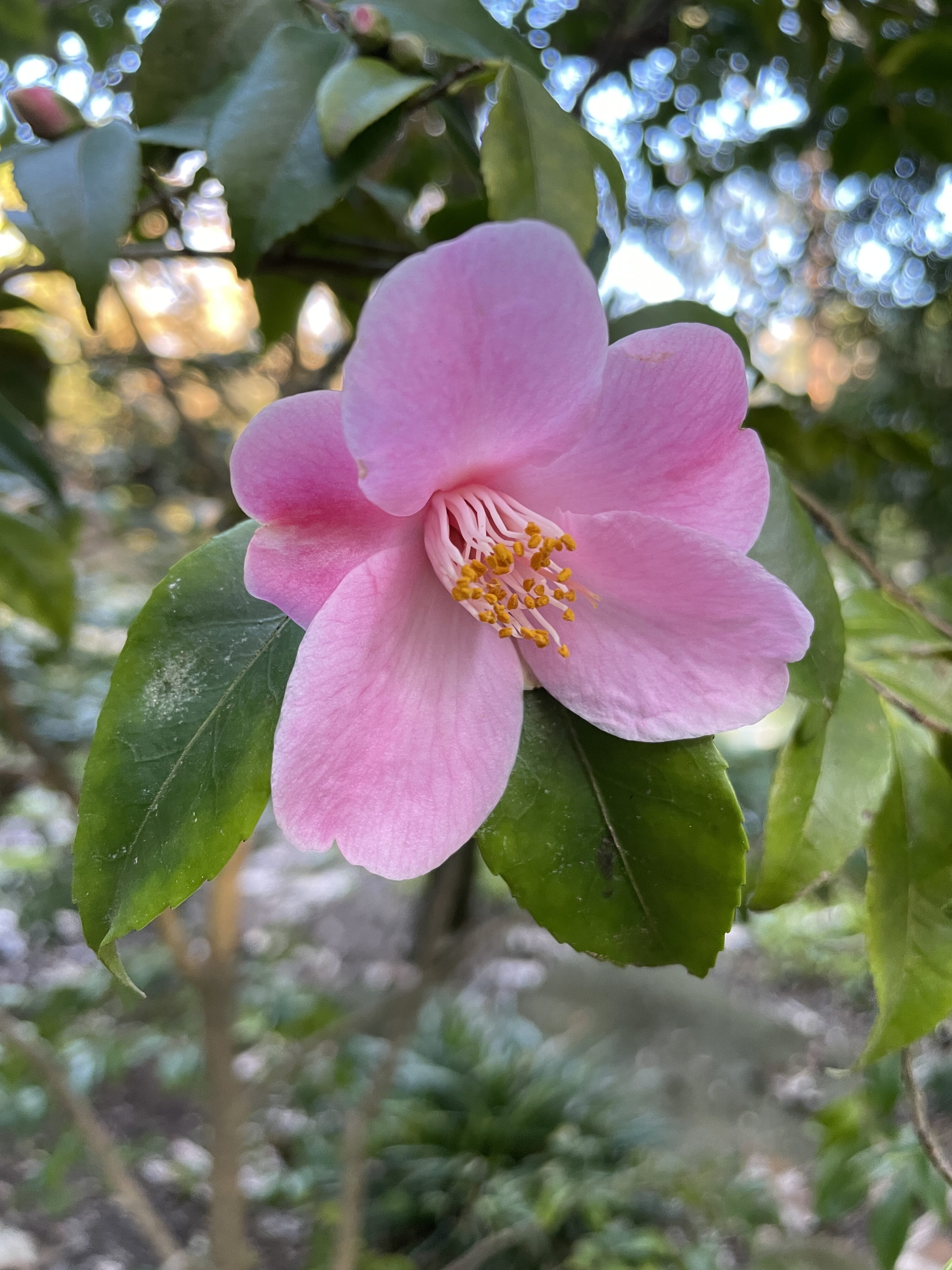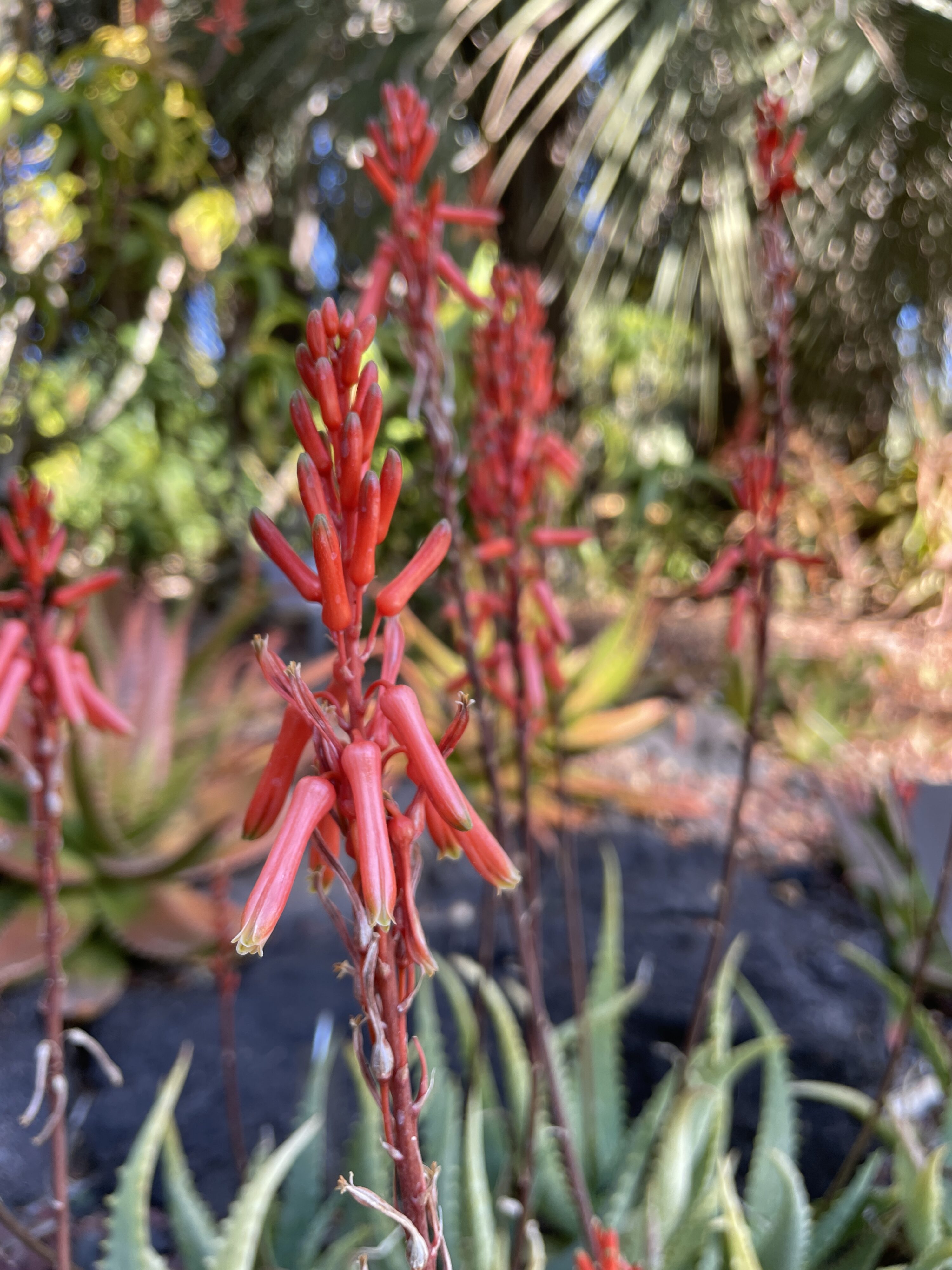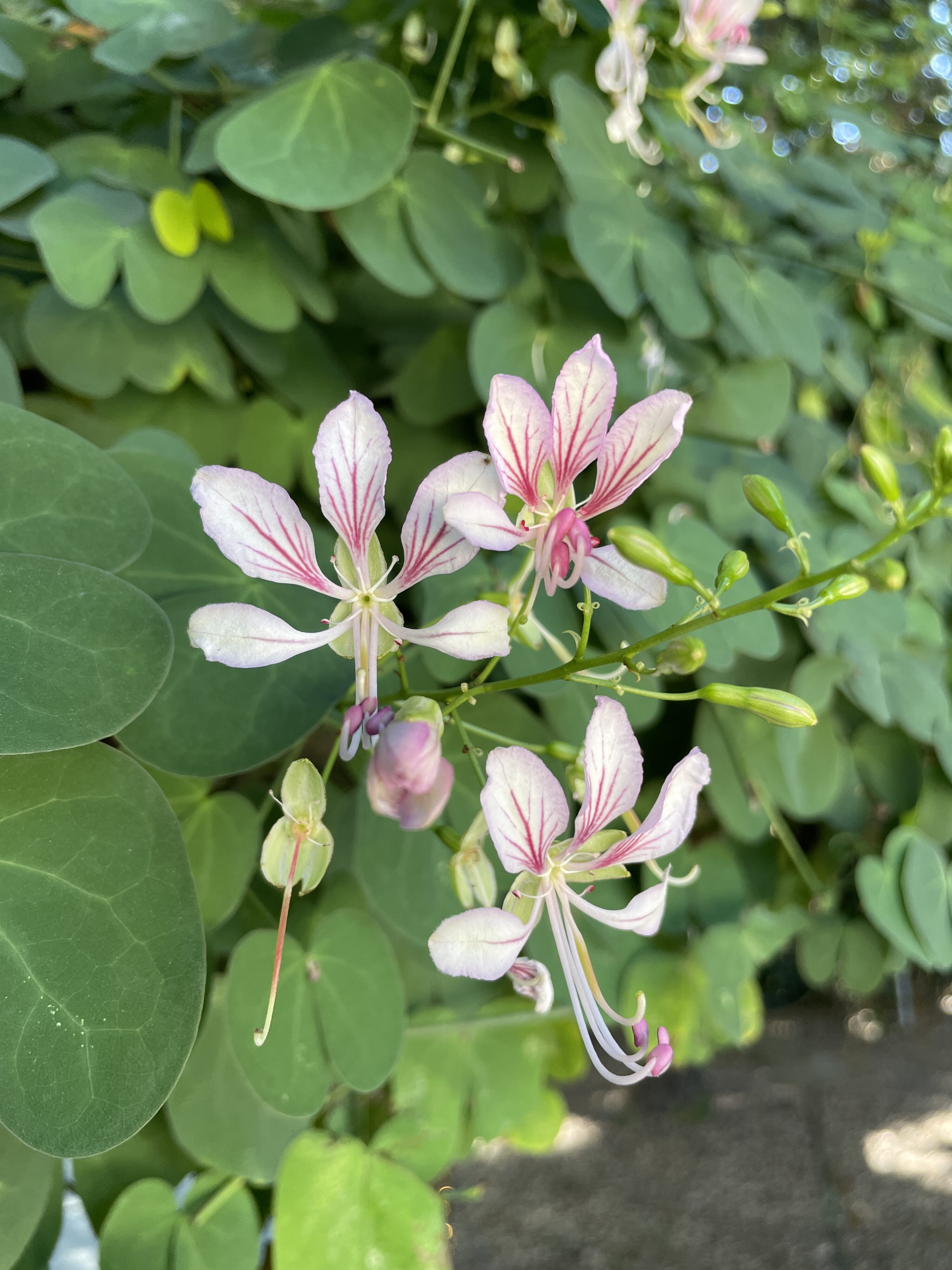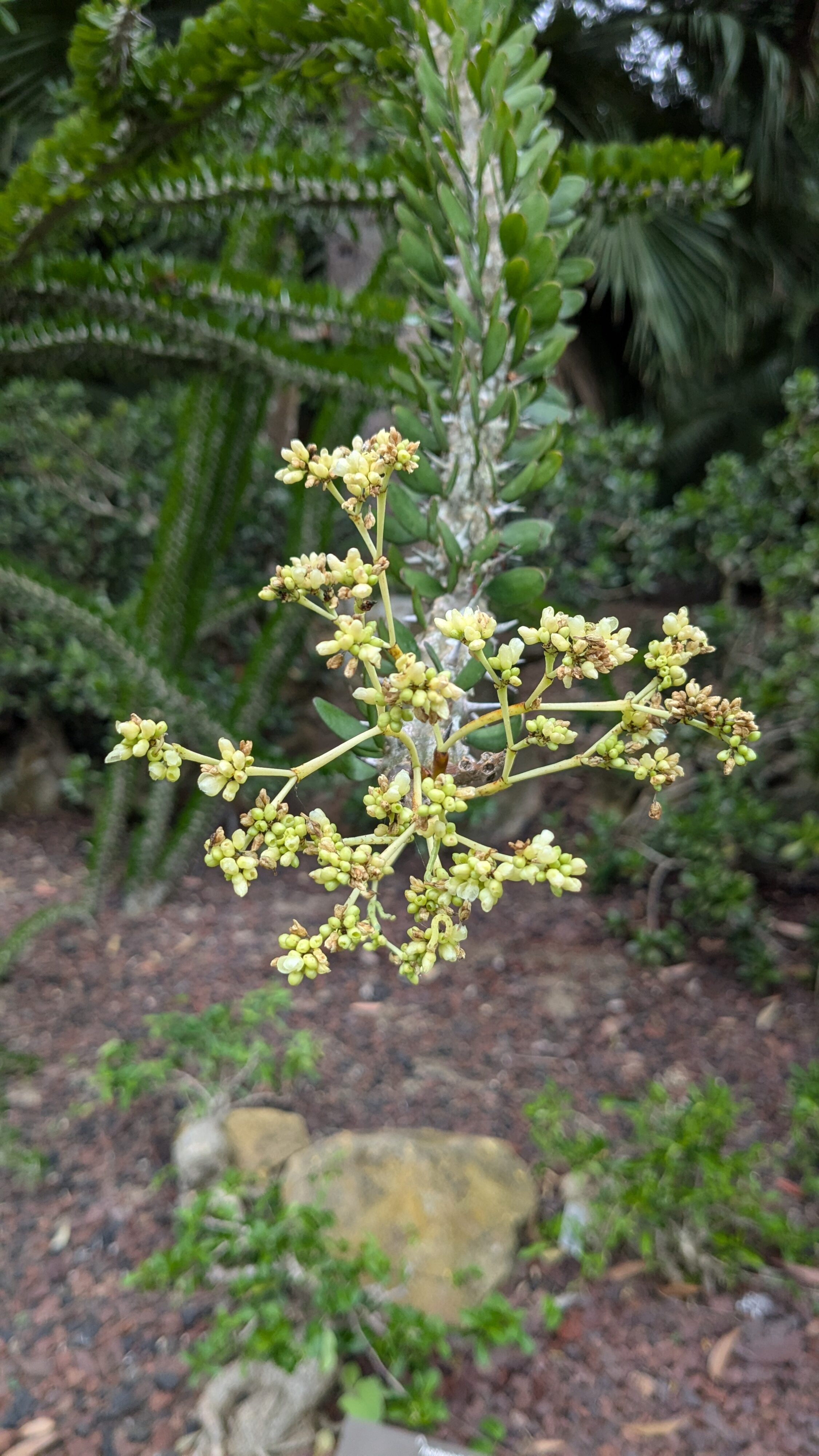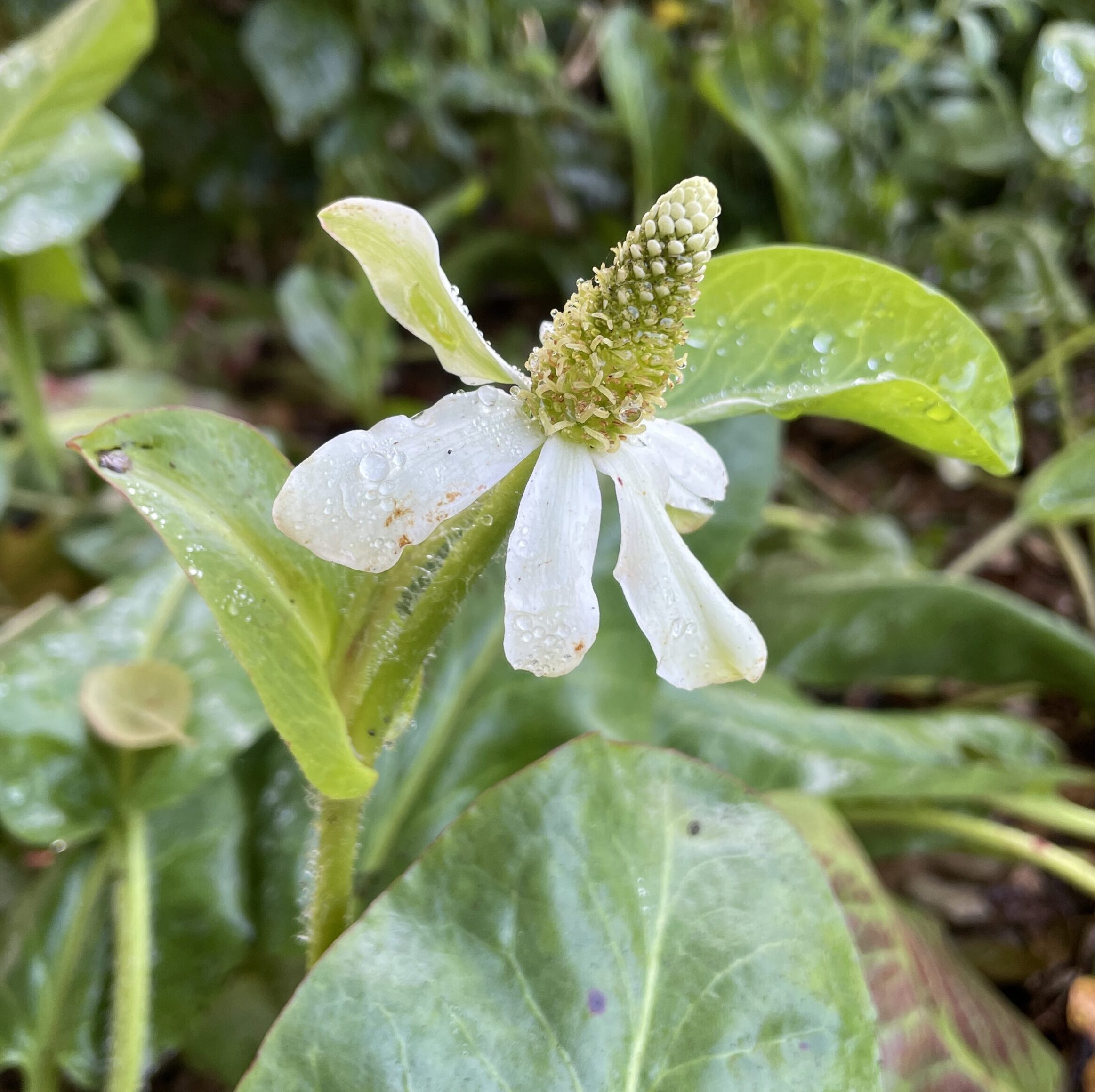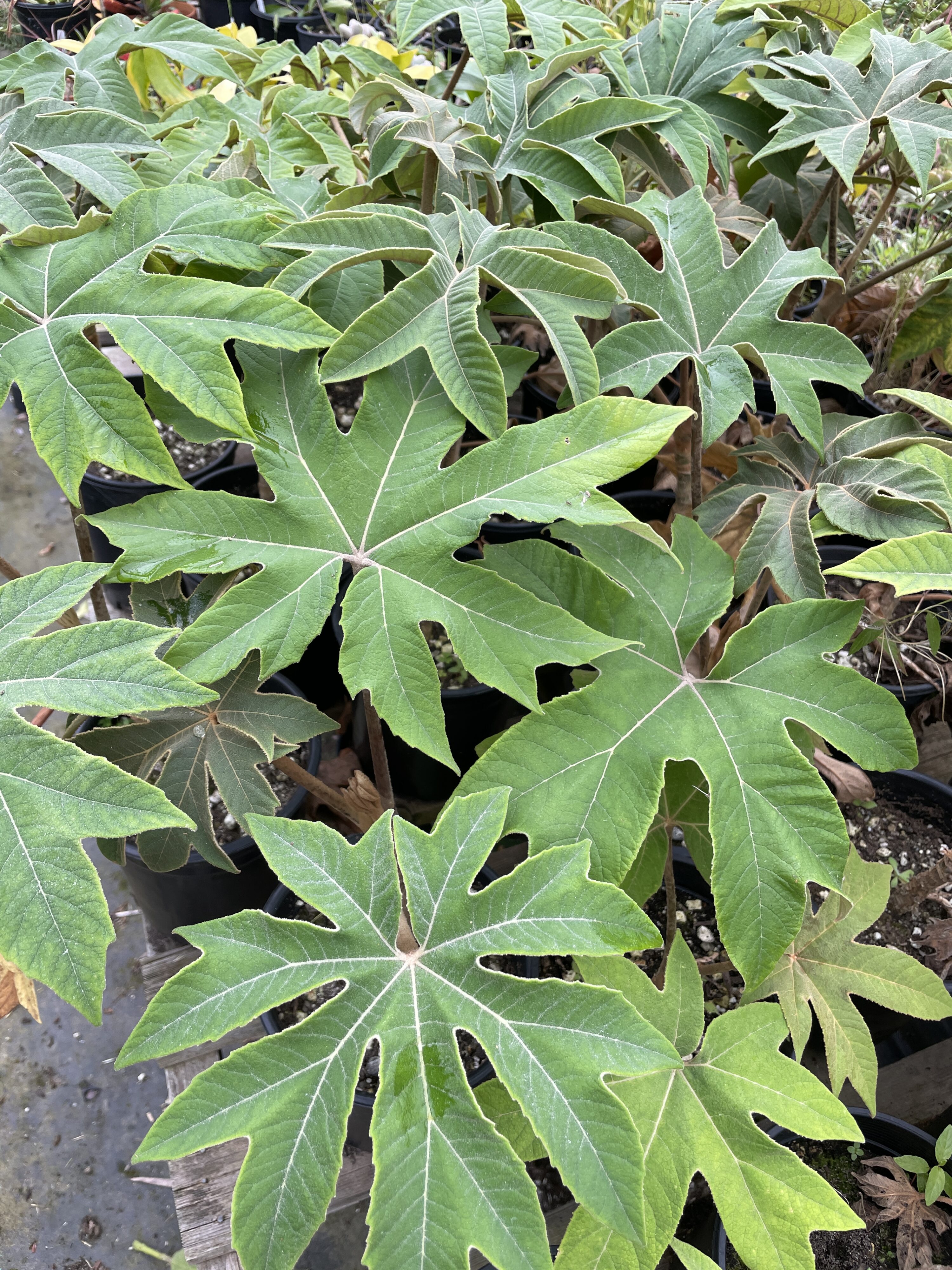
Plant Highlights
Plant Highlights
-
Euphorbia makallensis
sausage plant, hamat kolkwal
Highlight Month:
April
Nativity:
E. makallensis is native to the Tigray Region of northern Ethiopia where it is found in only two locations. The first recording, near Igre Hariba, was documented in 1975, and a second population was later found in 2011, 75km north in Hawzen.
Growth Habit:
This compact euphorbia is easy to grow and makes a great statement plant as a potted specimen or in the ground. In the wild, E. makallensis can form tuffet-like mounds up to five feet wide, resembling large rocky outcrops from a distance. At first glance, it resembles a miniature version of Euphorbia resinifera from Morocco. The stems of this plant are usually four-sided, edged with grey spine shields along the entire length, and produce spines in pairs of two. Flowering occurs in the late spring/early summer with bright yellow floral parts arranged in a unique structure called a cyathium.
Growing Requirements:
Well-drained soils, full sun.
Features:
Although this species had been in cultivation for some time, it wasn’t officially described as a new species until 1981 by researchers at Kew Gardens. The local Tigrinya name for this species is “hamat kolkwal” meaning “the mother-in-law of kolkwal,” in reference to the larger Euphorbia candelabrum.
Where at Lotusland:
E. makallensis can be found on the euphorbia side of the Main Drive at Lotusland near the entrance to the Water Garden.
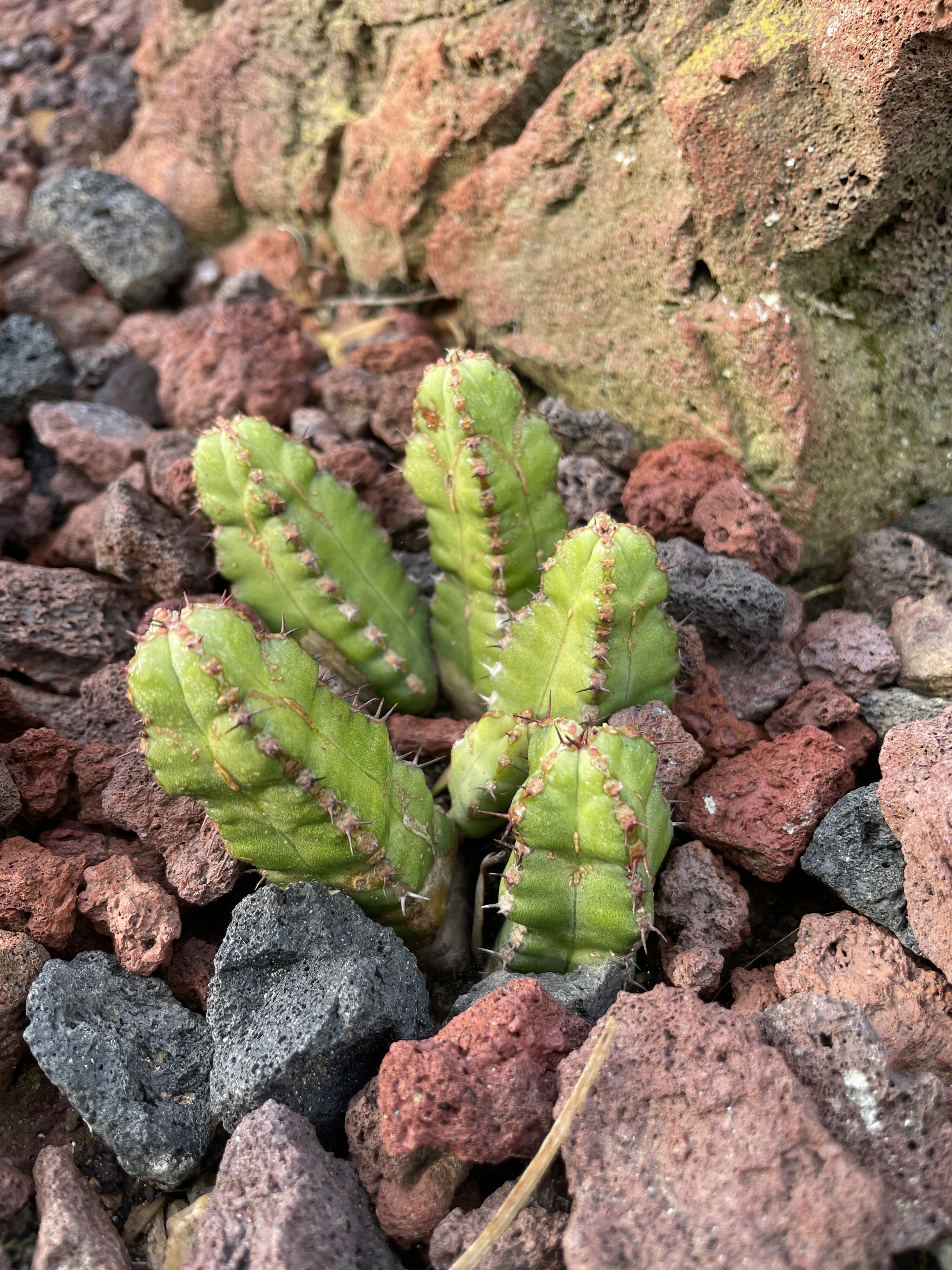
-
Magnolia x soulangeana
saucer magnolia
Highlight Month:
February
Nativity:
Garden Origin
Growth Habit:
This deciduous magnolia may grow as a multi-trunked or single-stemmed bush. It usually grows 10 to 15 feet in height. Flowers appear in early spring before the glossy green leaves.
Growing Requirements:
While perfectly happy in our Mediterranean climate, this magnolia will also thrive in temperate climates. Likes regular water and rich, well-amended soil.
Features:
The showy flowers are cup shaped, reddish purple on the outside shading to nearly white on the inside. It is a hybrid of Magnolia denudata and M. liliiflora.
The original Magnolia x soulangeana cross originates from France, where it was originally bred by plantsman Étienne Soulange-Bodin, and first flowered in 1826. Over fifty cultivars of Magnolia x soulangeana exist today.
Where at Lotusland:
Japanese Garden
-
Camellia ‘Minato-no-akebono’
Minato-no-akebono hybrid camellia
Highlight Month:
January
Nativity:
Garden Origin
Growth Habit:
This plant’s understated pink flowers have 5-7 notched petals with darker coloration towards the petal tips. They are borne profusely on this upright shrub from December to March. The entire plant has an open branching habit and can reach 5-9 feet high and 4-8 feet wide.
Growing Requirements:
Prefers regular water, full to part shade, and well-drained soils. It is hardy to USDA Zones 7-10.
Features:
The simple, light pink flowers may appear small on this camellia, but this winter-bloomer is highly scented, perfuming the air around it on a warm winter day with a spicy-sweet aroma. Camellia ‘Minato-no-akebono’ is a hybrid of Camellia lutchuensis, the source of the fragrance, and Camellia japonica ‘Kantō-tsukimiguruma’, adding increased cold hardiness and pink flower coloration. It originates from Yokohama, Japan where it was hybridized by Masaomi Murata in 1981 and officially registered in 1989. The cultivar name translates to “harbor at dawn.”
Where at Lotusland:
Camellia ‘Minato-no-akebono’ can be found in Lotusland’s Japanese Garden near the Torii Landing.
-
Aloe tororoana
Tororo Rock aloe
Highlight Month:
December
Nativity:
SE Uganda
Growth Habit:
Aloe tororoana grows on bare rocky slopes with decumbent stems. It is a perfect candidate for a small garden or container as it does not take up a lot of space. The leaves are a distinctive milky-green color and are covered in small white spots. Flowers are borne on 18-inch racemes, are coral-red with green tips, and appear in fall/early winter in Santa Barbara.
Growing Requirements:
Well-drained soil, sun
Features:
This species was originally described by Gilbert Westacott Reynolds in 1953 from Peter René Oscar Bally’s 1952 collection off Tororo Rock in SE Uganda. Originating over 250 million years ago, Tororo Rock is a volcanic plug created by hardened magma inside the vent of an active volcano. The now eroded remains are an iconic feature and tourist attraction in the town of Tororo. Additional populations of Aloe tororoana have recently been located in the nearby Osukuru Hills, as mentioned in the 2017 field guide, Aloes of Uganda by Thomas Cole and Tom Forrest. These outlying populations are under increasing threat due to phosphate mining, rock quarrying, and land clearing for housing and livestock grazing. A. tororoana is currently listed as Vulnerable by the International Union for the Conservation of Nature.
Where at Lotusland:
This species can be found in the Aloe Garden at Lotusland which houses two accessions, both of which are presumed propagations from the original 1953 Bally & Reynolds collection from the type locality.
-
Begonia angularis
Highlight Month:
October
Nativity:
South and SE Brazil
Growth Habit:
This species blooms sparsely in the upper leaf axils from winter to spring with white flowers. The leaves are a soft grey-green with attractive pale grey venation and occasional reddish undersides. The plant can reach over 8 feet tall in the landscape and is in the “cane-like” category, producing multiple stems from the base. Pinch the growing tips of tall stems to give it a bushier appearance. The specific epithet, angularis, references the uniquely angled stems with six prominent ribs, a defining characteristic of this species.
Growing Requirements:
Considered an excellent choice for the beginner begonia grower, B. angularis prefers shade, moist soils, and can be grown outdoors in Santa Barbara.
Features:
Begonia angularis is native to the Atlantic coastal forest of Brazil, an incredibly diverse region under threat due to ninety percent of the area being heavily fragmented by human activity. Almost two hundred Brazilian Begonia species occur in this cool, moist upland strip along the Atlantic Ocean, with only a few found in the adjacent Amazonian rainforests. This species was first described by Italian botanist Guiseppe Raddi in 1820 and introduced into European horticulture in 1845.
Where at Lotusland:
Fern Garden, between the pool and Dracaena Circle
-
Phanera yunnanensis
climbing Chinese orchid vine
Highlight Month:
October
Nativity:
South-Central China, Myanmar, and Thailand
Growth Habit:
This vining plant in the legume family comes from China, Myanmar, and Thailand and displays light pink flowers from late summer into fall. Vines reach 15-20’ long and require a structure or another plant to climb on.
Growing Requirements:
They prefer part to full sun for best flowering, are tolerant of drought once established and are hardy to USDA Zone 7b.
Features:
After decades of taxonomic reshuffling and reorganization of the subfamily Cercidoideae, 82 species have now been placed in the genus Phanera. P. yunnanensis was previously in the genus Bauhinia and continues to be sold as such at nurseries. Phanera are separated on the basis that all are vines or lianas (woody vines) with tendrils, have a lobed calyx, have 2-3 fertile stamens, and are distributed across Asia and Australasia.
Where at Lotusland:
Fern Garden entrance from Staff Parking Lot
-
Alluaudia procera
Madagascar ocotillo
Highlight Month:
September
Nativity:
Southern Madagascar
Growth Habit:
Native to arid southern Madagascar, Alluaudia procera belongs in the Didiereaceae, a small family which is known for plants with thick, water storing stems. The Malagasy name for Alluaudia procera is “fantshiholitra” which means “the tree with the spiny bark.” The genus name honors Charles A. Alluaud, a French entomologist (1861-1949). The specific epithet, procera, comes from the Latin, procerus, which translates to “tall or slender,” an apt description for these plants with their long stems that curve upwards and back creating a wispy look from afar. In the wild, A. procera can reach up to 60 feet tall, but record heights in California are about 25 feet tall. In Madagascar, the large grouping of them in the southwest is known as an ecoregion called the spiny forest. Their stems are grey and are covered in spines, which are modified leaves, that can grow up to four inches long. A. procera leaves have two orientations; coming out horizontally on new growth and vertically on mature growth. The common name, Madagascar ocotillo, references this plant’s resemblance to the unrelated but superficially similar Fouquieria splendens of the Southwestern United States and northern Mexico.
Growing Requirements:
A. procera is hardy in USDA Zone 9a from about 20-25° F, growing best in full sun. It can do well in a container or dry garden due to its low water needs. This means it is best to let the soil fully dry before watering and to avoid letting the plant get oversaturated.
Features:
Alluaudia procera is dioecious having clusters of male or female flowers that are quite small and a white to greenish yellow color. This species is semi-deciduous, frequently losing some or all of its leaves in the cold season.
Where at Lotusland:
Succulent Garden
-
Agave ellemeetiana
Ellemeet’s agave
Highlight Month:
August
Nativity:
This species was originally described in 1865 from material in European gardens but was recently re-discovered in the cloud forests of Mexico. Two subspecies exist: A. ellemeetiana ssp. ellemeetiana (from Veracruz and northern Oaxaca) with smooth leaf margins; and A. ellemeetiana ssp. subdentata (from western Oaxaca) with fine teeth, or denticles, on the margins.
Growth Habit:
This solitary agave lacks dangerous teeth on the margin and reaches large proportions in the garden. Its reflexed shiny green leaves are waxy and may turn slightly reddish at the tips when grown in full sun. Agave ellemeetiana superficially resembles A. attenuata, arguably the most common agave in Santa Barbara cultivation, but lacks the upright stem and blue, glaucous coloration to the leaves.
Growing Requirements:
Agave ellemeetiana is hardy to USDA Zone 10 and prefers full sun in coastal habitats and part shade when grown inland. Individual plants will reach 2-3’ tall and wide. It is one of the more shade tolerant agave species and grows on rocky cliff faces in cloud forest habitat alongside orchids and bromeliads. Consistent watering is recommended.
Features:
The specific epithet honors Jonkheer Willem Cornelis Mary de Jonge van Ellemeet (1811-1888), Dutch landowner, mayor, and holder of an extensive Agave collection at his estate near Oostkapelle in the Netherlands.
Where at Lotusland:
Agave ellemeetiana ‘Satina’ can be found at Lotusland near the Sycamore Canyon Road gate mixed in with the glaucous blue Agave franzosinii.
-
Anemopsis californica
yerba mansa, lizard tail
Highlight Month:
July
Nativity:
A. californica has a widespread distribution across the western and central United States and south into Mexico.
Growth Habit:
This California native plant makes a great addition in the spring and summer to wet areas of the garden. It is a low-growing groundcover spreading via stolons, similar to a strawberry plant. Individual plants only reach one foot tall and are composed of rosettes of aromatic elliptic leaves. Flowers are held on an upright cone-shaped spike subtended by creamy white bracts from March to September. In the fall, A. californica will take on a reddish hue as it begins its dormancy period. It may look a bit scraggly and can be cut back at this time or left to die back completely to the ground before it emerges again the following spring.
Growing Requirements:
This species prefers moist to wet environments along marshes and creek edges, is tolerant of saline and alkaline soils, and grows best in part shade to sun. It is hardy to USDA Zones 4-10.
Features:
Anemopsis californica is the only species in its genus and is a member of the Saururaceae, or lizard tail family. The genus name comes from the Greek, meaning anemone-like, referencing the inflorescence. The common name, yerba mansa, translates to “calming herb” in Spanish but this plant was never used medicinally for such purpose. However, it was used to treat conditions of the skin and blood and as a disinfectant.
Where at Lotusland:
Anemopsis californica can be found in the Insectary Garden at Lotusland where it thrives next to a large stone bird bath. Other related family members in the Garden include: Houttuynia cordifolia in the Japanese Garden and Saururus chinensis in the Water Garden bogs.
-
Tetrapanax papyrifer
rice paper plant, tung-tsao, bok-shung
Highlight Month:
June
Nativity:
Tetrapanax papyrifer is a fast-growing, sub-tropical shrub or tree from Taiwan and southern and central China. It is difficult to pinpoint its exact location of origin as it is widely grown across Asia for both ornamental and medicinal uses.
Growth Habit:
Check out our new Tetrapanax papyrifer next time you enter the Tropical Garden from the Main Drive at Lotusland. A small specimen was planted in January of this year, but it will quickly attain heights of 10 feet and can form a many-branched colony. In our climate, this species is semi-deciduous to evergreen, and our plant recently leafed out again after its brief winter dormancy.
The genus Tetrapanax is a member of the aralia or ginseng family (Araliaceae) and contains only one species. Other well-known genera in this family include: Aralia, Cussonia, Fatsia, Hedera, Pseudopanax, Heptapleurum, Schefflera, and Trevesia. The genus name refers to the flowers being held in groups of four (tetra) and its resemblance to the genus Panax. The inflorescence is a terminal panicle of round umbels holding creamy-white flowers and develops in late fall/early winter. T. papyrifer leaves are palmately lobed and covered in pale brown stellate hairs.
Growing Requirements:
T. papyrifer is hardy to USDA Zone 7b. When grown north of Zone 8 it may die back to the ground but will resprout from root suckers. It prefers full sun to partial shade.
Features:
Pith extracted from the branches is utilized in traditional Chinese medicine and was historically used to manufacture a paper-like substance. Small sheets of this pith-paper were carefully cut for watercolor paintings and artificial flower-making and, when introduced to Europe in the 1820’s, became known under the misnomer “rice paper.” Many of the pith paintings were sold as souvenirs to European tourists and depicted plants, animals, and scenes of life in China.
Where at Lotusland:
Tropical Garden



